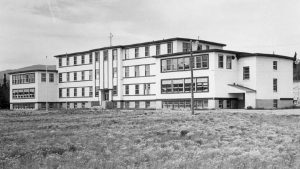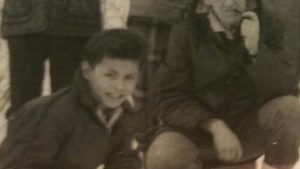Warning: This story contains distressing details about residential school and could be triggering for some.
More than 60 years after attending residential school, survivor Roy Johnson can still remember the horrific abuses he suffered with clarity.
At four-years-old, Johnson says he was sent to the Choutla Indian residential school in Carcross, Yukon, where he experienced traumatizing physical, emotional and sexual abuse.
While the federal government has compensated him for his time enrolled as a student at the school, Johnson is adamant Canada has failed him when it comes to acknowledging his suffering for the additional time he said he had to spend at residential school before he was enrolled as a student.
According to the federal government, Johnson was enrolled as a student at Choutla in 1957. But Johnson argues that’s not the case, and that he was actually sent to the school around age four in 1955.
“It’s the suffering,” Johnson said while recalling his ordeal. “(It’s) bothered me for a long time.”
Johnson, who is a member of the Tr’ondëk Hwëch’in First Nation, was born in October of 1951 in Dawson City, 530 km north of Whitehorse.
He says at age two he was sent to the Charles Camsell Hospital in Edmonton after he contracted tuberculous.
At around age four in 1955, Johnson recalls being discharged from the hospital in the wintertime and being sent on a plane by himself where he was met by a man who he thinks was the principal.
He was then taken to a classroom where he saw his two older brothers. Johnson said he was so young at the time that he “only came to his older brother’s thigh.”
Due to his young age, he said he was often left to play in the corner in classrooms where he was babysat by the teachers.
However, he said it wasn’t longer after his arrival that the abuses started – abuses he still remembers to this day.
Johnson said he witnessed countless incidents of staff beating students so brutally that their screams would often penetrate through the school’s steel double doors.
In one incident, he said the principal beat him with his own belt. Johnson said he was so angry at the time he stared at his abuser with “hatred eyes.”
“He would say ‘don’t look at me with those eyes,’” Johnson recalls. “I would turn away and feel relief because I wasn’t staring at him anymore. That would be one of my first experiences and many more after that with hate.”
Johnson said he would often witness severe punishments, like the principal beating several boys with large stemless willows if the children were caught going outside of the school’s perimeter.
“Every inch of their body was whipped. They were screaming,” Johnson said. “I can still remember looking out at the mountains standing at the back, crying, and telling myself someday ‘I’m going to tell this story.’”
Johnson said the most traumatic incident that happened to him during his time at residential school occurred while he wasn’t enrolled as a student.
He said at five-years-old he was raped and threatened by an older male student, which he suspects was a planned attack.
“I was only five,” he said. “Someone told me ‘forget about.’ I can’t. A five-year-old doesn’t want to, because he knows what happened to him.”
Johnson left the school in 1964 nearly illiterate at age 13. He said he eventually taught himself to read as an adult, an accomplishment he prides himself on.
Afterwards, he attended middle school and high school in Whitehorse, though he was expelled in 1968. He claims a teacher he had a previous run-in with accused him of cheating on a test, an incident that still bothers him to this day.
Johnson said the effects of residential school have been long lasting. In his earlier years he struggled with alcohol abuse, and due to his lack of education, has only been able to obtain part-time, seasonal and labourer-type work.
“(The pain) doesn’t go away,” he said.

‘I wasn’t a student’
While Johnson is adamant that he attended residential school in 1955 and 1956 before he was a student, he’s been unable to locate records that verify his claims.
As a result, the federal government has refused to compensate him for that time period.
Documents provided by Johnson show he received compensation under the Common Experience Payment (CEP) settlement in 2004. Johnson said he’s received $88,000 in total compensation, but was denied further compensation for the additional two years under the Independent Assessment Process.
“There is no information to suggest that underage pupils were admitted to this residential school at that time,” one of the appeal documents states.
But Johnson said he wants to be fairly compensated for the additional two years he attended school.
“(It’s) pathetic. It’s like throwing a handful of coins at you for all those years of suffering,” he said.
Johnson said a meeting with a government lawyer in the early 2000s to plead his case further frustrated him.
“(The lawyer) flat out didn’t believe me. He said ‘we don’t send children to residential schools at that age.’”
Johnson has also been unsuccessful in confirming his date of discharge from the hospital. An undated document states he had chickenpox in February of 1955 and would be considered for discharge in three months. However, no other information, like a date of discharge, is provided.
Another undated document, presumably from the hospital, incorrectly states his birthyear and refers to him as a girl.
With little recourse left, Johnson has written letters to form prime minister Stephen Harper and current Prime Minister Justin Trudeau. While their offices were sympathetic, the letters stop short of acknowledging Johnson’s claims and reiterate he was compensated through the CEP.
But Johnson sees it differently.
“(I wasn’t) a student. How can it be common experience?” he asks.

School before enrollment
Despite Johnson’s lack of documentation to back up his claims, cases of underaged children being sent to residential school were not uncommon.
Kaila Johnston, supervisor of education, outreach and public programming at the National Centre for Truth and Reconciliation, said there were a variety of reasons children might have been sent to residential school before the ages of six or seven, the typical ages of enrollment at the time.
She said records commonly show children were sent to a school if one or both parents were incapacitated and extended family was unable to care for the child.
“So that child was taken to the institution that could take care of them, which is often the residential school,” she said.
Johnston said other reasons for placing a child in residential school were as a form of protection or as a way to shield them from contracting tuberculosis. She said some cases even have notes of children being returned back to their community or adopted.
She noted one example of this is a residential school in the community of Île-à-la-Crosse in Saskatchewan. Documents show a principal added Metis students to the school’s register despite the children not having treaty status.
Johnson said the principal wrote to the department of Indian Affairs explaining there was no other institution that could care for the children as they were orphans and living in a remote community.
She said another example is the case of a young Inuit boy from the community of Coral Harbor, Nunavut in 1950.
A note attached to the school’s quarterly return, documents which residential schools submitted to get quarterly per capita funding, state the boy was moved from a tuberculosis sanatorium to the Brandon Residential school due to flooding.
“You can imagine the only institution that’s going to take a young Indigenous boy would likely be a residential school,” Johnson said.
The boy was later returned to Coral Harbor in 1952 as he had lost his language and it was feared he wouldn’t be able to fit in with the community.
Johnston said although survivors like Johnson were supposed to be given the benefit of the doubt when attempting to prove their experiences during settlement with the Federal government, this often wasn’t the case due to missing or destroyed records.
She noted an example of this that were 78 residential schools operating in 1948 but there are only quarterly returns for 68 schools.
“The loss and destruction of records has made it difficult to prove when a survivor has been in a school. You can imagine then how difficult it might be to try and piece things together,” she said.
“Although (Johnson) was living at that school, he was still subjected to things at that school. You would hope and expect that would be honored. We know that’s not the case.”
Compensation unlikely
Vancouver lawyer David Patterson, who specializes in Indigenous law, said despite the hardships Johnson has experienced his chances of legal recourse have long passed.
“The time (for getting compensation) was about a decade ago. At this point is there is no process to reconsider the matter. Everybody’s closed up shop and gone home,” he said.
“All of the funds that were left over once the Common Experience Payment process was shut down and were then transferred and this was provided for in the settlement agreement itself.”
As the appeal process is also now closed, Patterson said Johnson could go to court to plead his case, though his chances for receiving compensation are slim due to the time that’s passed.
“If there is a process open to him, it would be a political one, and that would be either lobbying with a member of parliament for an extra payment,” he said. “If there were more people like him coming forward and raising problems with this, then it is possible that the issue could be given some life in the political forum.”
Like Johnston, Patterson notes the settlement process likely undercompensated underaged survivors as they were unable to prove their claims due to a lack of documentation.
“You have what at the end of the day is a legal process, and sometimes complicated legal process that individuals were brought into and often didn’t receive the results they wanted. The mechanisms for challenging that were obscure and complicated, and especially if you go to court, somewhat difficult for an individual to do,” he said.
“The objective of the settlement agreement was to achieve reconciliation or at least to make some steps in that direction, and for some people it didn’t work out that way and that’s unfortunate.”
Johnson said he might consider legal action against the Federal government, though he acknowledges he’s facing an uphill battle.
However, he’s adamant his case is worthy of a second look.
“There’s a difference because I wasn’t a student. I sat in the classroom, but I wasn’t a student…I was a small baby boy.”
Apology needed
Despite his experiences, Johnson is pushing to share his story after the discovery of 215 suspected unmarked graves at the Kamloops residential school in May of 2021.
“When they found all those children buried, I think at the time I was quite angry. They found children younger than me,” he said.
In 2008, Johnson was invited to attend former Prime Minister’s Stephen Harper’s apology for residential school. While he wanted to take the opportunity to tell Harper about his case, he ultimately decided not to as he didn’t think it was appropriate at the time.
Now, he’s hoping to get the apology he feels he deserves so he can heal.
“It’s very important because of the brutality that we went through.”









